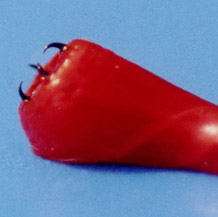Latest News

Chestnuts used chemicals to dominate southern Appalachian forests
USDA Forest Service research confirms that chemicals in the leaves of the American chestnut suppress the growth of other trees and shrubs-and probably played a part in the species’ past dominance of the southern Appalachian forest.
Southern Research Station ecologist Barry Clinton (Coweeta Hydrologic Laboratory)-with fellow researchers from Clemson University and the University of North Carolina-Chapel Hill-tested the effects of fallen chestnut leaves on five tree species that historica

Gene therapy success in the laboratory buoys hope for Parkinson’s disease
Scientists at Jefferson Medical College have used gene therapy to reverse the progression of Parkinson’s disease in rats. They have found that by adding a gene for an enzyme, they were able to reprogram brain circuitry and halt the deterioration of dopamine producing brain cells, one of the key problems in the disease.
“It’s not just inserting a replacement for a missing or mutated gene as a treatment for a genetic disorder,” says Michael Oshinsky, Ph.D., research assistant professor of neu

Bloodworm’s way with copper likely provides paradigm for new materials
Researchers report in the Oct. 11 “Science” the first detection of a living organism that makes a copper-containing mineral structure as part of its skeleton. The finding is remarkable because the amount of copper detected in the jaw tip of the marine bloodworm would normally be toxic to an organism.
The researchers determined that copper also occurs in non-mineral form in the bloodworm jaw where it may act as a structural element in cross-linking long chains of fibrous proteins. According

Shadow proteins in thymus – Clues to how immune system works?
Findings could lead to new understanding of diabetes, Crohn’s, and more
Researchers at Joslin Diabetes Center, Harvard Medical School, and other institutions have identified the function of a protein, dubbed aire, that is critical to helping immune cells learn to recognize–and avoid attacking–the far-flung organs and tissues of the body. The protein appears to work by turning on in the thymus, which lies beneath the breast bone, the production of a wide array of proteins from the bo

To Detect Cyberattacks, New Software System Developed at UB Profiles ’Normal’ Computer Habits
An early version of a new software system developed by University at Buffalo researchers that detects cyberattacks while they are in progress by drawing highly personalized profiles of users has proven successful 94 percent of the time in simulated attacks.
The “user-level anomaly detection system” was described here today (Oct. 10, 2002) at the military communications conference known as MILCOM 2002.
“We have developed a new paradigm, proactively encapsulating user intent where y

First web drug map under construction
The first complete map of drug related web-sites on the Internet is under construction. Dr Fabrizio Schifano and colleagues at St George`s Hospital Medical School in Tooting, London, will collect and analyse data from web-sites relating to the design and sale of recreational and illicit substances. The purpose is to provide healthcare professionals in the European community with as much information as possible on the latest drugs – drugs that are often unrecorded in medical textbooks.
The la










